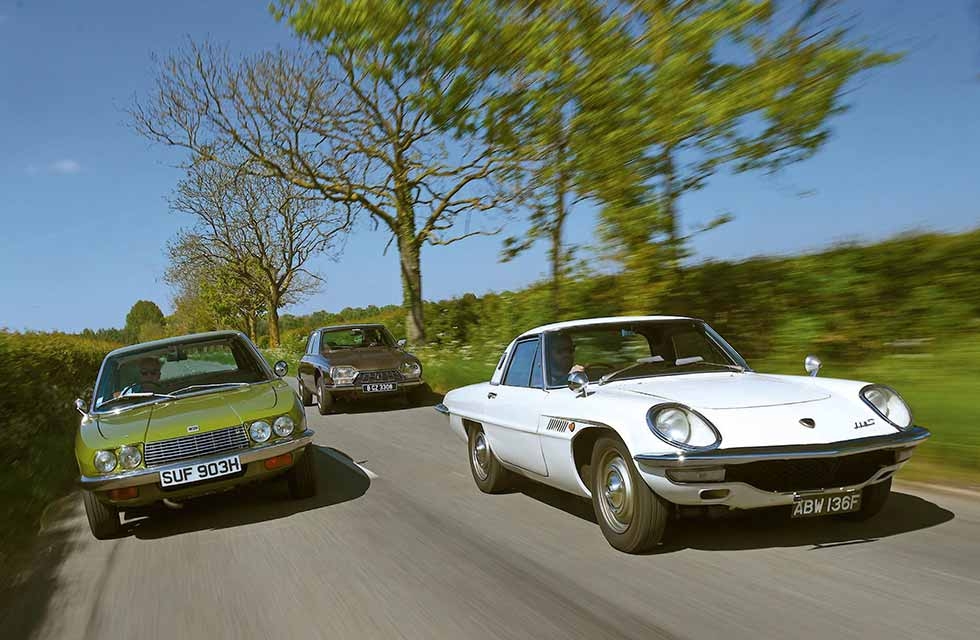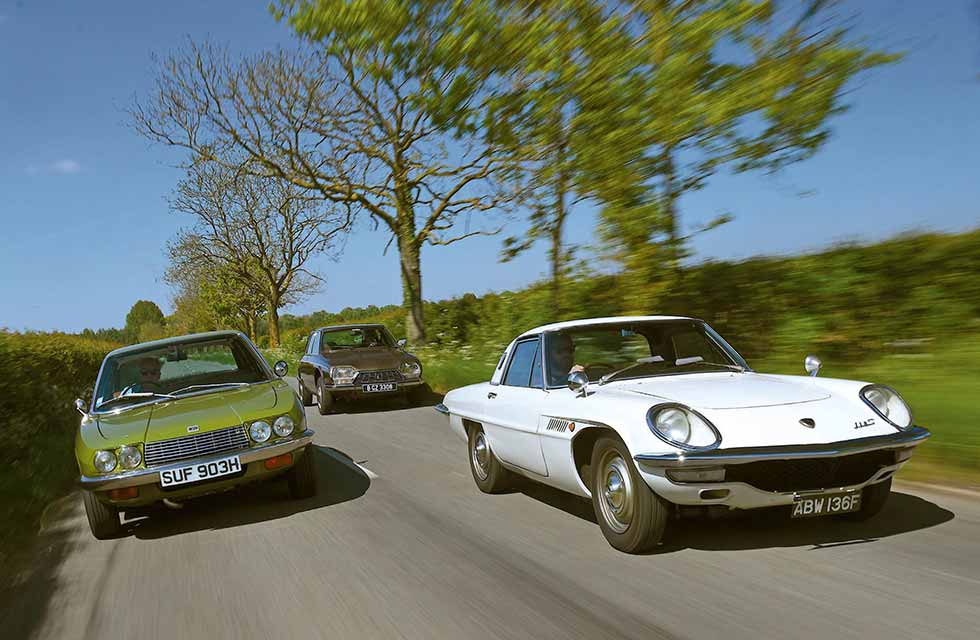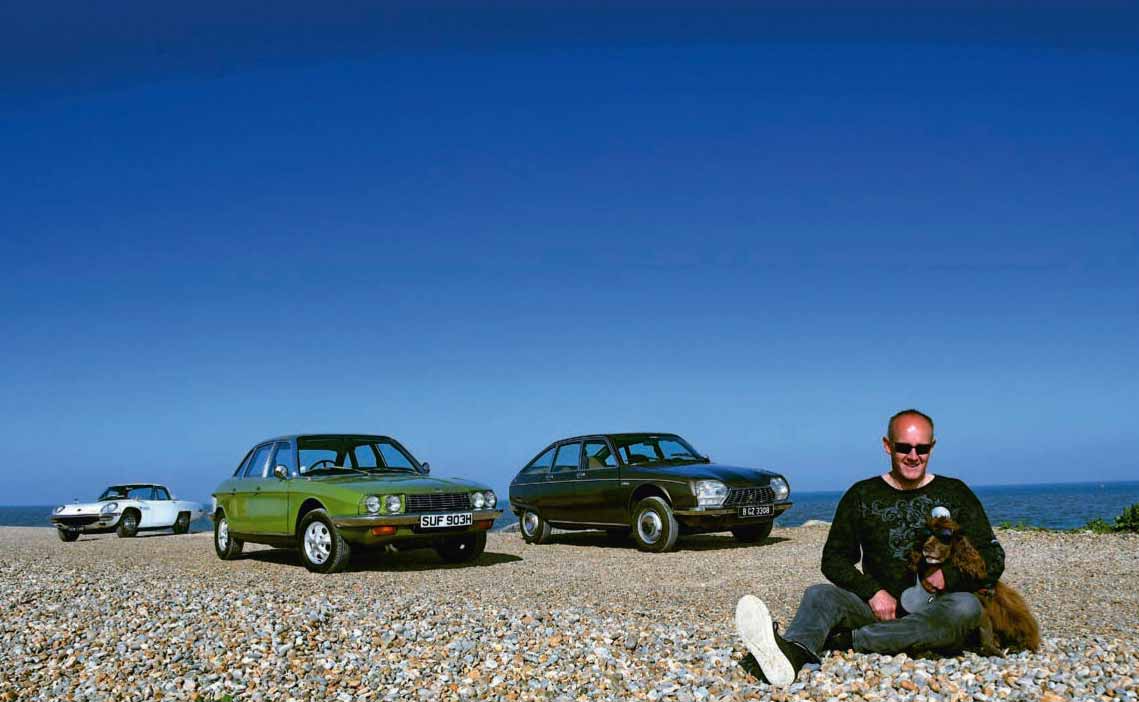
Three car rotation. Rotary club: Mazda Cosmo, NSU & Citroën The NSU Ro80, Citroën Birotor and Mazda Cosmo are cars united by one cult concept – and one careful owner. Words Martin Buckley. Photography John Bradshaw.
GETTING IN A SPIN
Wankel’s rotary revolution, with Mazda Cosmo, NSU Ro80 and Citroën Birotor
Phil Blake owns a lot of cars – more than 30 at my conservative estimate – but there is nothing random or undisciplined about his collection’s theme: rotary power. And if that number of cars suggests a wild-eyed hoarder or some other form of social misfit, I can assure you that Blake is rational, organised and quite ‘normal’: an electronics technician by day, sometime DJ by night, he is a rounded man of many passions beyond motor cars.

But even he would admit that none run deeper than his fascination for these smooth, compact and elegantly simple engines that 50 years ago were being hailed as the first serious challenge to conventional reciprocating piston power.
It wasn’t to be, as we know. Mazda kept the Wankel flame alive until 2012 with the RX-8 but attempts to curb its thirst, emissions and patchy reputation for longevity had sealed its fate. Blake’s love affair began in the 1980s when he was a south London teenager with a £200 NSU Ro80, driven illicitly when his parents weren’t around – until a neighbour grassed him up. It didn’t put him off: he admits to owning almost 30 of these stylish, prophetic German saloons.
Blake progressed in parallel through various more pedestrian rotary RX Mazdas of the ’70s before acquiring one of the ultimate prizes in the world of Wankel-engined cars, a 110S Cosmo. That was almost 20 years ago. Since then, this sleek, futuristic-looking two-seater has gone up in the world. No longer is it a slightly geeky curiosity of the embryonic Japanese motor industry, it’s now a £100,000 collector’s piece, perhaps second only to the Toyota 2000GT in the realm of Nipponese classics.

Nestling in the bosom of rural Suffolk, the smart but unrestored white 1968 Cosmo is the pride of Blake’s collection, not even usurped by the much more recent acquisition of a yet more obscure Wankel-engined vehicle, the semimythical Citroën GS Birotor. With the same price-tag as a DS23 Efi (but a greater thirst), it’s probably no surprise that the French marque only built 847 of these GS-based oddities. The surviving examples would doubtless be in therapy if they were people: disowned by its parent, Citroën in fact tried to save itself the bother of having to supply parts for its unloved progeny by attempting to buy back and destroy all of them. Around a third are thought to survive, although I doubt many are as nice as this one.
In comparison, the NSU Ro80 was only a qualified failure. Produced for 10 years from 1967-’1977 and to the tune of 37,204 cars, this slippery, wedge-profiled five-seater made the most convincing argument for the benefits of Felix Wankel’s super-smooth and compact engine. It received rave reviews, not just for being the first twin-rotor production saloon, but for its overall excellence as a car, too. Arguably there was no finer big saloon at the time, a remarkable achievement from a company better known for mopeds and rear-engined economy cars.
Initial sales were brisk, but engine failures gave buyers the wobbles (instead of waving to each other, German Ro80 owners would proffer fingers in greeting to indicate the number of replacement engines they’d had), and no amount of assurances in the early ’70s about improved reliability could tempt them back.
Meanwhile, bankrupted by generously honoured warranty claims, NSU had become part of the VW-Audi group in 1969. The new bosses might reasonably have been expected to bury the loss-making Ro80 at the first opportunity, particularly during the 1973 fuel crisis.
That they gave the Ro such a long reprieve says something for the regard in which the car was held, not only as a group flagship but also as a symbol of West German technological prowess. Where the Ro80 ultimately failed nobly, the Cosmo 110S – launched slightly ahead of the NSU in 1967 – was the first step towards the huge sales success of the RX-7 in the ’70s and ’80s. Mercedes-Benz C111 aside, it was already the Holy Grail of the rotary world when Blake bought this one from Ivan Dutton in 2000.
Of the 1176 cars built through to ’72, nobody seems to know how many came to the UK in period (at £2600 they were pricey), but this one originated from a Mazda dealer in Spain before turning up at an auction at Beaulieu in 1990, less original engine and with a cracked ’screen. One of two (or possibly three) 110S Cosmos now residing in the UK, this is actually Blake’s second example. “I found the first one in a scrapyard in Warwickshire in 1989,” he says. “I gave £1500 for it, which was quite a lot at the time given that it was a complete shed.”
Thought to have been the 1968 Motor road-test car, the black project Cosmo was sold a few years ago to help fund the Birotor purchase. “The white car has proved an even better investment,” says Blake. “Not only because of the huge spike in its value, but also because it has needed virtually nothing doing to it.”
It is a good-looking car that could somehow only be Japanese in the way it seems to mix Italian, British and even American styling cues; there is something Thunderbird about the roof and long tail, a touch of Elan about the nose, and yet the overall feel is of a shape that could have originated on a late-’50s Alfa Romeo show car. That rather squares with the background of the Cosmo, because although production began in 1967, the design was frozen in 1962 and it was first seen in public at the Tokyo show in 1964.
Eighty pre-production cars were built for dealers and the factory test department, and production settled down to a car a day from the end of 1967 in Hiroshima. Officially it was only badged as a Cosmo in its home market: export cars such as Blake’s are badged as the 110S. There were two versions. Blake’s is the original L10A type (343 built) with 110bhp from a four-plug, twin-distributor, twin-rotor engine breathing through a four-barrel Hitachi carburettor.
It’s nominally rated at 2 litres, with each of the rotors worth twice their 491cc swept volume. A further 833 L10B Cosmos were built from 1968 to ’72 with 128bhp, five speeds and a longer wheelbase, but still with de Dion rear suspension and front discs and rear drums, now with a servo.
I have been waiting to drive this car for years and it does not disappoint. Lower-slung and dinkier than it appears in pictures, the 110S is cosy but not cramped inside. The décor of functional black finish and generously abundant and cleanly calibrated instrumentation is along 1960s Jaguar and Lotus lines.
There is excellent 360º vision, and with a well-spaced pedal, steering and gearchange relationship you instantly feel that you are in a sports car. And that is half the battle won. In the interests of low-down torque, smoother idle and part-throttle characteristics Mazda had a preference for straight inlet porting rather than NSU’s autobahn-friendly peripheral ports. The Cosmo is as happy to potter at low speeds as it is to sing around to 7000rpm with that smooth hum that can only be a rotary engine. Those revs would give you 120mph in top, but it’s more fun to flick through the indirect ratios in the delightful ’box with its stubby lever and slicing action.

With a slight rearward weight bias (the compact engine is mounted well back in the bay), the Cosmo is a really agile, go-where-you-point-it car with light and neutral steering, lots of adhesion and very little body roll. The ride is firm and flat, which confirms the car’s sporting rather than gran turismo aspirations.
If it’s hard to think of a Japanese car I’d want more than a 110S Cosmo, then the appeal of the Citroën GS Birotor is a little more difficult to fathom – though appeal it certainly has in spades. Its commercial failure was one of the deciding factors in Citroën’s bankruptcy (and subsequent takeover by Peugeot), not so much on the basis of those 847 cars but because of its joint investment with NSU in a company called Comotor.
The two firms plotted to build rotary engines in a new factory 30 minutes east of Luxembourg, Citroën having satisfied itself of the feasibility of a Wankel-powered car by doing a dry-run of 267 specially adapted Ami coupés fitted with a single-rotor 49bhp engine. Known as the M35, these were handed out to ‘special customers’ for evaluation between 1969 and ’1972, complete with a window sticker advising other road users.
With its various external drives for the hydropneumatics, the Birotor’s peripheral-port engine – transversely mounted and mostly obscured by the spare wheel – looks different externally to the Ro80 unit. Internally it is identical to the German, the lower power rating of 106bhp presumably down to tune and losses associated with the brake and suspension pumps.
With a three-rotor CX prototype waiting in the wings, it’s odd that Citroën chose the compact three-year-old GS as the basis for its first rotary vehicle when, presumably, buyers of the bigger car would have been more open to the idea of a more powerful and technically advanced engine. Even if it was rather thirsty.
It’s not even as if much of the Birotor is interchangeable with a standard GS; beyond the obvious flared arches and five-bolt wheels, much of the suspension and underpinnings are unique to the car or shared with the CX. The front disc brakes being outboard, rather than inboard, was just one of many differences.
With 5300km on the clock, Blake’s Birotor is effectively brand new, being one of an unknown quantity given a reprieve from the crusher. In this case, a merciful French Citroën dealer sent the unsold 1974 Birotor’s identity paperwork and chassis plate back to Citroen during its post-1975 cull, pocketed the generous compensation but kept the car, running it on trade plates when he wanted to take it to a show.
The second owner brought the Birotor to the UK. When a Citroën specialist, stumped by the rotary engine, failed to get it running for him Blake was called in and he had the Birotor fired up within half an hour. Naturally it was love at first sight, and in April 2018 Mr Philip Blake became its first registered keeper.
Sitting higher, on taller wheels with fatter tyres, it looks subtly more aggressive than a regular flat-four GS. Its two-box profile suggests a hatchback, when all you get is a normal bootlid.
Just as most 110S Cosmos are white, most Birotors seem to be chocolate brown or light gold with a contrasting roof finish. The brown theme continues inside where, to justify a pricetag that was 70% higher than the most expensive air-cooled GS, Citroën gave the Birotor full carpeting, circular instruments and front seats with built-in headrests. On the centre console there’s a button and a gauge to monitor engine oil levels, a reminder that rotary oil consumption is much higher than with a piston engine.
Like NSU, Citroën adopted a semi-automatic three-speed gearbox for the Birotor to mask the lack of low-speed torque and overrun snatch. Known as the C-Matic (in Citroën speak), it demands that you time your changes carefully until you have acclimatised: generally smooth, it won’t be rushed. On the other hand, second is a useful all-purpose 80mph gear so you don’t have to use it all that much, even in town driving.
The C-Matic doesn’t compromise the feel of the car, which is smooth and lively, happier the harder it is extended and always with that feeling of smooth unburstabilty as the revs keep coming. Certainly no other GS had anything like this car’s urge, and with its anti-roll bars and that smaller, lighter engine there is less roll, understeer and tyre squeal to contend with.
Chasing Blake in the Ro80 back to his rural rotary compound, the Birotor easily keeps station with the German car, floating serenely along on its hydropneumatics like any other GS. To have such an isolating big-car ride in something so compact was one of the great features of these flat-four Citroëns, and the Birotor would end up being the one and only production car to mix hydropneumatics and a Wankel engine.
Blake’s green 1969 Ro80 is one of the first right-hookers, sold new to a British Army captain in Germany. He returned to the UK in 1973 and kept the car until he died in 2002, which was when Blake managed to capture it. I still find the Ro80 beautiful, yet the austerely practical interior feels at odds with the dramatic exterior. But you grow to like its simple dash and pleasingly open floor area in front, which has minimal transmission-hump intrusion.
On the move it feels far quieter and more ‘executive’ than the others, unflappably competent yet far from just another bland Teutonic saloon. The body roll appears much more alarming from outside than it feels from within, and it rides, grips and stops beautifully on those skinnily shod Fuchs alloy wheels.
The long suspension travel makes a mockery of road humps and the strong brakes are much easier to modulate than the highly powered type fitted to the Citroën.
The Ro80 is happy to wind around on twisty roads, but it is at its best when striding out on to long, straight, high-speed routes where it can hold its momentum for hours on end in a state of total stability. This is what the car was all about, and why it was the true and natural home for the Wankel rotary engine.
‘The Ro80 ultimately failed nobly; the Cosmo 110S was the first step towards the huge success of the RX-7; and the Birotor’s commercial failure was one of the factors in Citroën’s bankruptcy’
With four spark plugs, four circular lights and vinyl seats, this car is typical of the ‘Mk1’ Ro80s. It has done just 76,000 miles, many of the past 10,000 on trips to European NSU meetings. Blake is not shy of going any distance in these supposedly ‘unreliable’ cars and, while by no means blind to their faults, remains an evangelist for the Ro80 cause, committed to getting more of them into the hands of people who will appreciate one of the great cars of the ’60s.
Of his many Ro80s, four are currently on the road and two are for spares, but the rest are eminently restorable prospects. If you speak to him nicely he might sell you one, or even restore it for you. As for the Mazda Cosmo and the Citroën Birotor? They’re going nowhere, so don’t even bother asking.
Citroën GS Birotor
Sold/no built 1973-’1975/847
Construction steel monocoque
Engine iron-block, two-rotor 995cc Wankel, with two Solex carburettors
Max power 107bhp @ 6500rpm
Max torque 101Ib ft @ 3000rpm
Transmission three-speed semi-auto, FWD
Suspension independent, at front by wishbones rear trailing arms; hydropneumatic self-levelling f/r
Steering rack and pinion
Brakes powered discs
Length 13ft 6 ¼ in (4120mm)
Width 5ft 4 ¾ in (1644mm)
Height 4ft 6in (1370mm)
Wheelbase 8ft 3 ¼ in (2522mm)
Weight 2513Ib (1140kg)
0-60mph 13.3 secs
Top speed 109mph Mpg 20-22
Price new £3000 Price now £30,000
From top: hydropneumatic suspension ensures gliding progress; chocolate brown seems the default choice. Opposite, clockwise from bottom right: distinctively styled trio; spartan NSU cabin; Cosmo has the most exotic feel; quirky GS with single-spoke wheel.
NSU Ro80
Sold/no built 1967-’1977/37,402
Construction steel monocoque
Engine iron-block, two-rotor 995cc Wankel, with two twin-choke Solex carburettors
Max power 113.5bhp @ 5500rpm
Max torque 117lb ft @ 4500rpm
Transmission three-speed semi-auto with torque converter, FWD
Suspension independent, at front by MacPherson struts, anti-roll bar rear semitrailing arms, coil springs, telescopic dampers
Steering ZF power-assisted rack and pinion
Brakes discs, with servo
Length 15ft 8 ¼ in (4782mm)
Width 5ft 9 ¾ in (1772mm)
Height 4ft 8in (1422mm)
Wheelbase 9ft 4 ½ in (2858mm)
Weight 2632lb (1196kg)
0-60mph 12.6 secs
Top speed 112mph
Mpg 16-20
Price new £2444 (1970)
Price now £5-12,500
Main: twin headlamps replaced the rectangular lights in 1969 – the metal grille was swapped for plastic a year later. Below: name is derived from its internal designation, Typ 80, which was already taken by Mercedes.
Mazda Cosmo 110S
Sold/no built 1967-’1972/1206 (including pre-production cars)
Construction steel monocoque
Engine two-rotor 982cc Wankel, with twin spark plugs per chamber and Hitachi-Stromberg four-barrel carburettor
Max power 110bhp @ 7000rpm
Max torque 96Ib ft @ 3500rpm
Transmission four-speed manual, RWD
Suspension: front independent, by wishbones, coil springs, anti-roll bar rear de Dion axle, trailing arms, semi-elliptic leaf springs; telescopics f/r Steering rack and pinion
Brakes discs front, drums rear (with servo from 1968)
Length 13ft 5 ½ in (4102mm)
Width 5ft 2 ¼ in (1581mm)
Height 3ft 9 ½ in (1156mm)
Wheelbase 7ft 2in (2184mm)
Weight 2111lb (958kg)
0-60mph 10.2 secs
Top speed 116mph
Mpg 18-21
Price new £2607
Price now £100,000
Main: recognisable lines of the Cosmo take inspiration from the Ford Thunderbird, with Mercedes-esque ‘eyebrows’ over the wheels – designs were agreed five years before the car made its way onto the forecourt. Below: long, chiselled tail.





